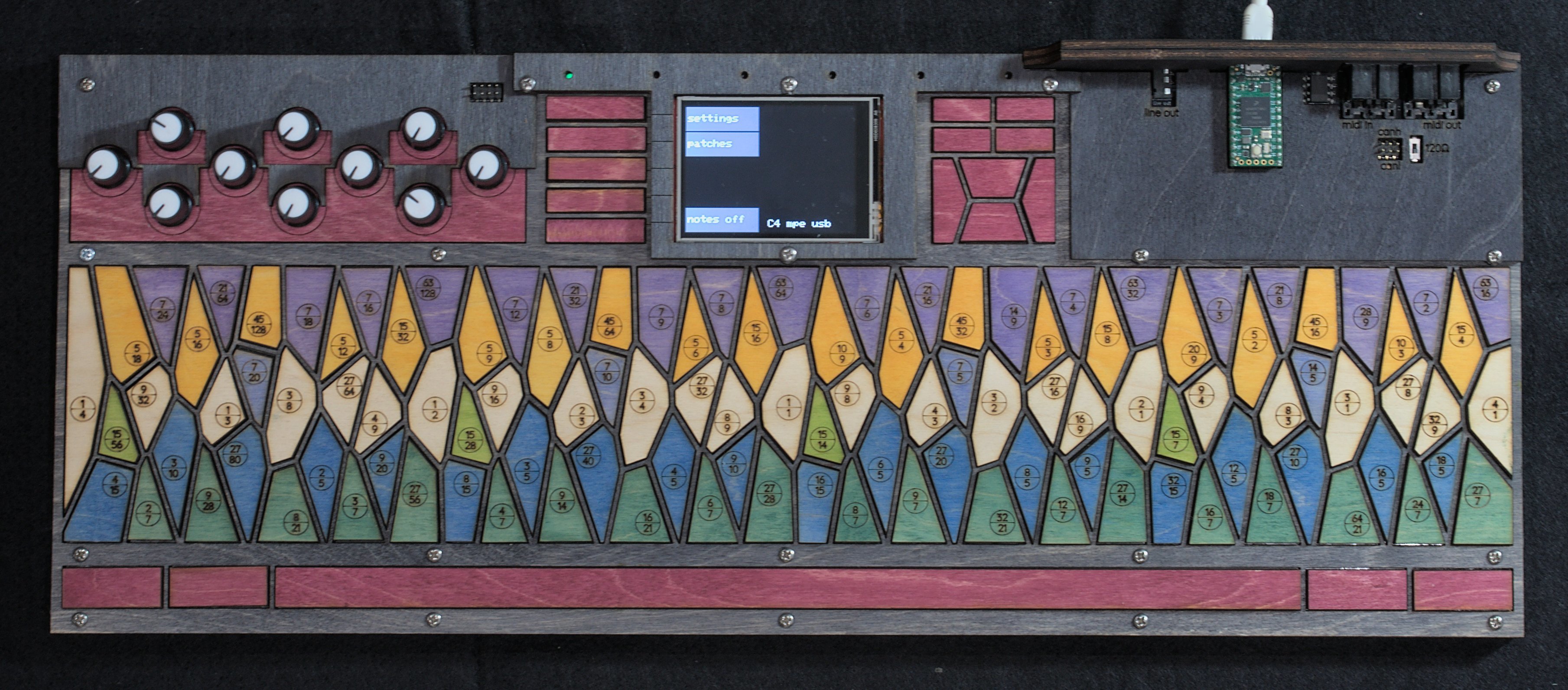
The Mosaichord is a new kind of expressive electronic music controller, designed to provide easy access to more notes per octave than are available in traditional 12-tone equal temperament.
The Seven Limit Mosaichord is the first available model, with a 28-note per octave scale designed to acommodate five and seven limit just intonation.
The Mosaichord can be used to control external synthesizers, and also has a built-in sound engine that uses subtractive synthesis.
Well, maybe. It depends. As far as we know there's nothing on the market quite like it, but there are other controllers that may serve just as well, depending on your needs and budget. The Linnstrument is arguably the closest thing. The Linnstrument has more expressive control (being able to sense exact X and Y position on the surface in addition to pressure), but it makes a few different design and user interface trade-offs. It's primarily designed around 12-tone equal temperament (though the ability to bend notes means it's not bound to exact 12-TET). There is at least one project to add support for other equal temperaments, but it's a work in progress.
The main distinguishing feature of the Mosaichord is that it's explicitly and unappologetically a just intonation instrument, in which the frequencies of all the notes in the scale are related to one another by whole-number ratios. The keyboard is laid out to work with a particular set of notes that seemed to be sufficient for most 5-limit and and 7-limit music, as long as it doesn't wander too far from the key center.
Given that this is a new product, there are some rough edges. The software works pretty well, but lacks a few features you might expect like the ability to save settings across reboots. (This is in testing, but hasn't been released yet.) Most important settings can be set via the built-in menu system, but some of the more obscure settings are only configurable by tweaking the source code directly.
(Speaking of source code, it's available on Github here. You don't need to edit the source code yourself just to use the Mosaichord, but you can if you want to -- and you may want to to customize your setup.)
The keybed itself may occasionally need some maintenance. I've tried to make the keys as sensitive as I can without getting any false-positive key-presses, but the trade-off of high sensitivity is that tiny bits of lint or whatever can get on the printed circuit board (PCB) contacts and cause stuck keys. At the same time, the gold plating can oxidize over time making the keys less pressure sensitive. In either case, the fix is to remove the 22 screws holding everything together, disassemble the keyboard, peel back the force sensitive resistor from the keybed, and clean the traces (I use isopropyl alcohol), then put everything back together. It takes about as much time as changing strings on a guitar.
The keys themselves are made of birch plywood, and are dyed various colors according to the prime factors in the ratio printed on each key. Given the nature of things made of wood and assembled by hand, there are typically some minor cosmetic differences between any two Mosaichords.
Yes and no... it's mostly just different. The same familiar notes from standard tuning are there, but without the tempering they sound a little bit more like what they always were. The keys are labelled by the ratio that the frequency of the sound makes with respect to the tonic (1:1, which by default is middle C). There are a bunch of "new" notes involving the prime number 7 that don't usually show up in mainstream modern music, which you can use or ignore depending on whether they serve the musical goals of any particular song.
As is typical of just intonation instruments, you have to be mindful of distinctions between notes with slightly different pitches that in standard tuning would just be the same note (i.e. enharmonic equivalents), and to stay mostly centered around one key, as you sort of run out of notes if you wander too far from the starting point. (In just intonation, there are an effectively infinite number of potential notes, and we can't make a physical keyboard with infinite keys.)
On the other hand, the Mosaichord can make music more approachable by making the underlying math more explicit. It's a lot easier to figure out what's really going on when the notes are identified as ratios that are subject to basic math. This tends to appeal to people who want to understand music from first principles rather than memorize a bunch of arbitrary-seeming rules.
(From time to time, one may want to play the Mosaichord treating some other note than the center 1:1 key as the tonic. To make this easier, I've produced a collection of keyboard diagrams labelled and colored as if some other note was the tonic, which can be found here: 1/1 16/15 15/14 10/9 9/8 8/7 7/6 6/5 5/4 9/7 21/16 4/3 27/20 7/5 45/32 3/2 32/21 14/9 8/5 5/3 27/16 12/7 7/4 16/9 9/5 15/8 27/14 63/32)
We don't have a web store up and running yet, but we do have several Seven Limit Mosaichords in stock. The regular price is $800, shipping included. Contact me by email to make an order. We're shipping to U.S. only at this point.